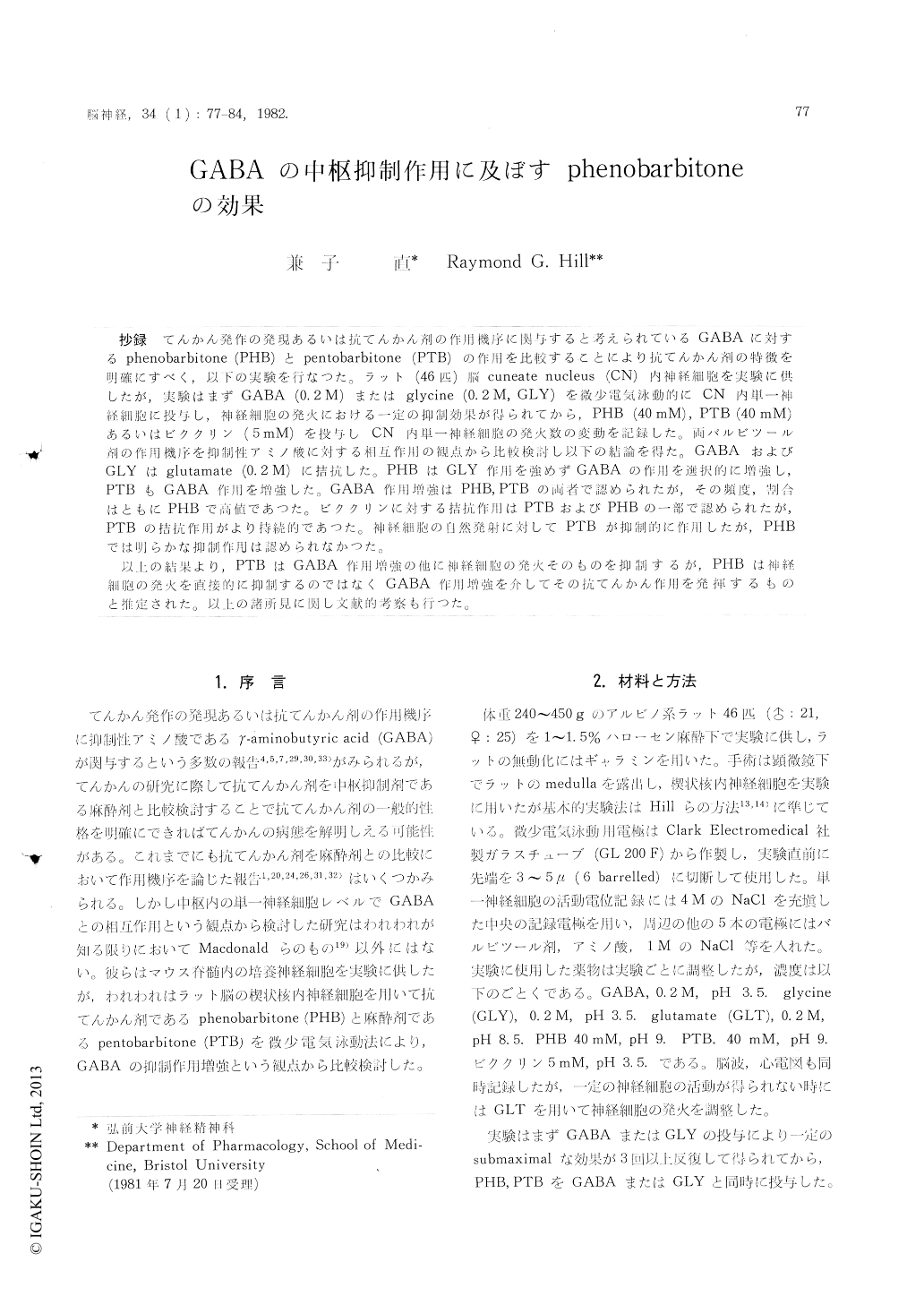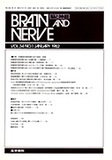Japanese
English
- 有料閲覧
- Abstract 文献概要
- 1ページ目 Look Inside
抄録 てんかん発作の発現あるいは抗てんかん剤の作用機序に関与すると考えられているGABAに対するphenobarbitone (PHB)とpentobarbitone (PTB)の作用を比較することにより抗てんかん剤の特徴を明確にすべく,以下の実験を行なつた。ラット(46匹)脳cuneate nucleus (CN)内神経細胞を実験に供したが,実験はまずGABA (0.2M)またはglycine (0.2M,GLY)を微少電気泳動的にCN内単一神経細胞に投与し,神経細胞の発火における一定の抑制効果が得られてから,PHB (40mM),PTB (40mM)あるいはビククリン(5mM)を投与しCN内単一神経細胞の発火数の変動を記録した。両バルビツール剤の作用機序を抑制性アミノ酸に対する相互作用の観点から比較検討し以下の結論を得た。GABAおよびGLYはglutamate (0.2M)に拮抗した。PHBはGLY作用を強めずGABAの作用を選択的に増強し,PTBもGABA作用を増強した。GABA作用増強はPHB,PTBの両者で認められたが,その頻度,割合はともにPHBで高値であつた。ビククリンに対する拮抗作用はPTBおよびPHBの一部で認められたが,PTBの拮抗作用がより持続的であつた。神経細胞の自然発射に対してPTBが抑制的に作用したが,PHBでは明らかな抑制作用は認められなかつた。
以上の結果より,PTBはGABA作用増強の他に神経細胞の発火そのものを抑制するが,PHBは神経細胞の発火を直接的に抑制するのではなくGABA作用増強を介してその抗てんかん作用を発揮するものと推定された。以上の諸所見に関し文献的考察も行つた。
It is well documented that the action of barbi-turate anaesthetics and anticonvulsants might partly be related to the inhibitory neurotransmitter γ-aminobutyric acid (GABA). To clarify the mecha-nisms of action of anticonvulsant phenobarbitone, the interaction between phenobarbitone, pentobar-bitone and GABA were studied on cuneate neurones of rats. Experiments were performed on 46 albino rats (240-450g) lightly anaesthetized with 1 to 1.5% halothane and prepared for recording from the brain stem.
Six barrelled glass micropipettes were used to record extracellular action potentials from single neurones in the medulla, and to administer sub-stances close to them by standard micro-iontophore-tic techniques. Freshly prepared solutions of GABA (0.2M, pH3.5), glycine (0.2M, pH3.5), glutamate (0.2M, pH8.5), (+)-bicuculline methochloride (5mM, pH3.5), phenobarbitone (40mM, pH9.0), pentobarbitone (40mM, pH9.0) were administered iontophoretically from the outer barrels of six-barrelled micropipettes, the 4M NaCl-containing centre barrels of which were used to record extracellular action potentials of single neurones. Reproducible responses to GABA and glycine were obtained during consecutive iontophoretic administrations of these compounds during a fixed time sequence. The effects on these responses of iontophoretically administered barbiturates were determined. In order to maintain a steady firing rate of the neurone, glutamate was used on most of the neurones tested.
The results were as follows :
1) GABA and glycine clearly antagonized the responses to iontophoretically applied glutamate.
2) Phenobarbitone markedly potentiated the re-sponses to GABA (34. 0±6. 74), but not to glycine, and a similar effect was seen for pentobarbitone (21. 3 ±1. 9%) to iontophoretically applied GABA.
3) The success rate of potentiation of GABA was 80% for sodium phenobarbitone and 40% for pentobarbitone, while mean iontophoretic current of phenobarbitone was significantly lower than that of pentobarbitone (p <0. 05).
4) Pentobarbitone reversed the GABA antago-nism induced by iontophoretic application of bicu-culline. Phenobarbitone also reversed the antago-nism by bicuculline of responses to GABA although this was less readily observed.
5) Pentobarbitone, but not phenobarbitone, de-creased the spontaneous neuronal firing rates.
These results indicate that the effects of both barbiturates to be similar but phenobarbitone is more selective in potentiating GABA while pento-barbitone had direct action on neuronal firing as well as the action of GABA potentiation. This enhanced inhibition and reduced excitation are a plausible basis for pentobarbitone and enhanced inhibition mediated by GABA potentiation is a major basis for phenobarbitone. The present data may provide a clue to the specific nature of phe-nobarbitone's antiepileptic action.

Copyright © 1982, Igaku-Shoin Ltd. All rights reserved.


